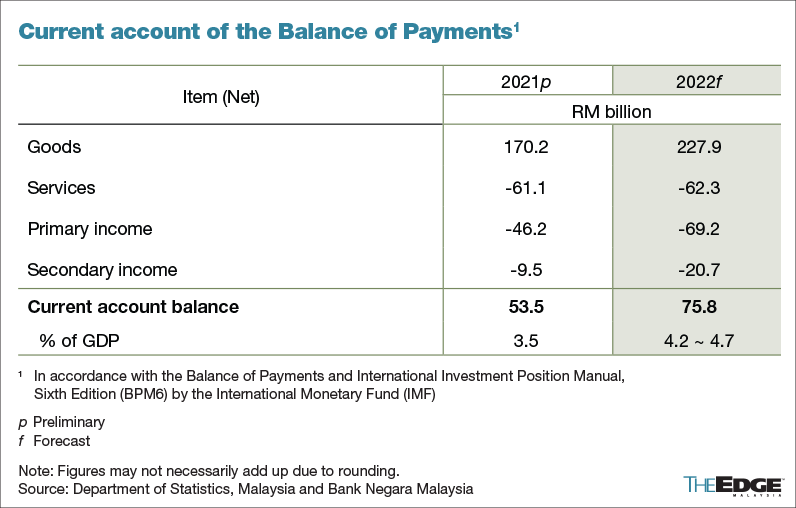
KUALA LUMPUR (March 30): Malaysia’s export is likely to grow by 10.9% in 2022 from 26% in last year, driven by continued external demand especially from Malaysia’s key trade partners, according to Bank Negara Malaysia (BNM).
In the central bank’s Economic and Monetary Review 2021 (EMR 2021), BNM said that as the 12th largest electrical & electronics (E&E) exporter in the world according to IHS Markit’s 2021 trade data, Malaysia will continue to benefit from the strong global demand for E&E products, driven by digitalisation and automation.
The central bank highlighted that improvements in commodity production and higher prices of crude oil, liquified natural gas (LNG) and crude palm oil (CPO) will boost Malaysian exports in 2022.
In terms of manufacturing exports, BNM expects an expansion of 5.3% in 2022, compared to 25.6% in 2021, supported by broad-based expansion across all segments.
BNM added that Malaysia is expected to continue benefiting from strong semiconductor demand, in line with a 10.4% growth in global semiconductor sales forecast in March 2022 by the World Semiconductor Trade Statistics (WSTS). This is further supported by the central bank’s regional economic survey which suggests E&E firms will have healthy order books in 2022.
Meanwhile, higher commodity prices and production will continue to drive robust growth in commodities exports in 2022, with BNM projecting a 45.8% growth this year, compared to 29% in 2021.
BNM also expects agriculture products exports to be supported mainly by CPO exports, driven by higher prices and expected gradual easing of labour shortage.
Minerals exports growth is also expected to be underpinned by higher prices and production, as new gas fields are expected to commence operations, while the OPEC+ (Organization of the Petroleum Exporting Countries) cuts output in the latter part of 2022, according to BNM.
Meanwhile, BNM also expects gross imports to expand by 8.1% in 2022, compared with 23.3% in 2021, citing higher intermediate imports in line with continued growth in manufactured exports.
Capital imports and consumption imports are also expected to grow due to recovery in investment activity and improvement in consumer spending amid better income and employment conditions.
Current account to register higher surplus of 4.2% to 4.7% of GDP
Despite higher imports and exports, BNM expects the goods surplus, strong external demand and higher commodity prices to contribute to a higher surplus for the current account of the balance of payments, at between 4.2% to 4.7% of the gross domestic product (GDP).
The services account in Malaysia is predicted to remain in deficit, weighed mainly by transportation services as trade activities remain strong, according to the central bank.
It added that the reopening of international borders to inbound tourists will see higher travel receipts, which supports the slight narrowing of the travel deficit.
However, BNM said the pace of international travel recovery is expected to be gradual but remain below 20% of pre-pandemic levels, as some countries remain risk-averse while imposing international travel restrictions.
BNM said that primary income account is estimated to record a wider deficit, mainly attributable to higher income payments accrued to foreign investors in Malaysia amidst improvement in the domestic growth outlook, while the secondary income account is expected to record a larger deficit driven by higher foreign worker outward remittances.
Read more stories from the BNM Annual Report 2021 here.


